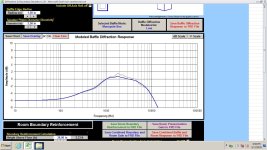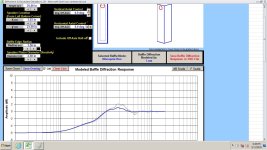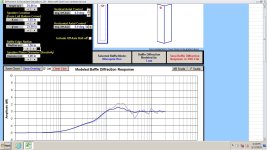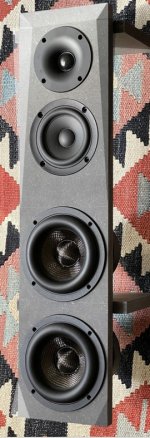Your simulations of edge radius effects are consistent with what I have simulated and measured on many projects in the past. The benefits of a modest 15 mm to 25 mm radius are so clear and obvious.
These graphs are hard to compare due to the size. Which comparison do you feel shows the biggest advantage? I'm assuming the tweeter without a wave-guide.If these are correct, rounded edges are good for TW and about the same for mid.
May I ask what frequency you think you will be crossing the tweeter?
yes, this simulation shows beveling the baffle is very good. I now plan to bevel.Your simulations of edge radius effects are consistent with what I have simulated and measured on many projects in the past. The benefits of a modest 15 mm to 25 mm radius are so clear and obvious.
yes, a bit hard to see. I am comparing sharp vs rounded. both bare tweeter (title '1in') and tweeter in WG ('1in WG') show very good improvement from rounding.These graphs are hard to compare due to the size. Which comparison do you feel shows the biggest advantage? I'm assuming the tweeter without a wave-guide.
May I ask what frequency you think you will be crossing the tweeter?
Crossover will be somewhere in the 2k-3.5k range and will be decided after driver sweeps.
The mid does not seem to benefit from rounding to the same degree, only a little bit. The bevel will still extend to the midrange driver, so will be some minor benefit and will look better.
Last edited:
If you want to bevel, bevel. It will look nice. Make sure you think about bevel depth and the under-lying material and what it will look like if you cut through the layers. You might end up needing to paint.
If you're going to bevel by hand, you might want to avoid straight lines between bevel edges. Straight lines that aren't straight stand out. (If you're comfortable with doing this, then ignore this part)
Point:
If you uncheck the off axis roll off, and compare square edge/off axis and rounded/on axis, you'll see the dip is basically the same in each.
So yes, round overs 100% help. But it's minor. Depending on listening axis, it may be completely in-audible.
EDIT: It's minor on this narrow of a front baffle.
But bevels do look better. Have fun.
If you're going to bevel by hand, you might want to avoid straight lines between bevel edges. Straight lines that aren't straight stand out. (If you're comfortable with doing this, then ignore this part)
Point:
If you uncheck the off axis roll off, and compare square edge/off axis and rounded/on axis, you'll see the dip is basically the same in each.
So yes, round overs 100% help. But it's minor. Depending on listening axis, it may be completely in-audible.
EDIT: It's minor on this narrow of a front baffle.
But bevels do look better. Have fun.
Valchromat is rather even and could work even unpainted. But I plan to paint anyway.
I will try to bevel on a table circular saw. If we manage the jig, then in will be straight cuts at an angle, top and sides (like on the drawing).
Failing that will attempt to sand manually (oscillating tool) and I think I will have to soften all angles to allow for imprecision of manual work.
I am really enjoying the design and build process. And I am climbing a steep learning curve - in both acoustics/speaker design and in woodworking skills. I have grossly overestimated my level of knowledge in loudspeakers and my ability to learn VituixCAD.
I will try to bevel on a table circular saw. If we manage the jig, then in will be straight cuts at an angle, top and sides (like on the drawing).
Failing that will attempt to sand manually (oscillating tool) and I think I will have to soften all angles to allow for imprecision of manual work.
I am really enjoying the design and build process. And I am climbing a steep learning curve - in both acoustics/speaker design and in woodworking skills. I have grossly overestimated my level of knowledge in loudspeakers and my ability to learn VituixCAD.
It's not that I'm opposed to you doing round-overs, or large bevels. I have then on my favorite build. I think you are not looking closely. In addition, this thread will be seen by many, and the comments so far by several here, make it sound like a slam dunk improvement. You mentioned a wild swing, of 6dB I think. That's not the case. Here's some Sims using the same exact software, so you can verify this yourself. These may be huge on some computers, but at least they can be ready by anyone.
I have superimposed the tweeter responses with, and without the round-over. Also, I might point out that 1.5" radius is rather large. You have a wave-guide tweeter, so why even look at a standard 1". I don't know if the 20 degrees driver roll-off is even worth a look. I'll leave it anyway, since you posted the same.
Note: These are 2dB scales, so you can very easily see the differences. It appears to me that at most you might improve the 2k response by 1dB. Is it worth the effort?
I still would like to know what the tweeter will be crossed at.
I have superimposed the tweeter responses with, and without the round-over. Also, I might point out that 1.5" radius is rather large. You have a wave-guide tweeter, so why even look at a standard 1". I don't know if the 20 degrees driver roll-off is even worth a look. I'll leave it anyway, since you posted the same.
Note: These are 2dB scales, so you can very easily see the differences. It appears to me that at most you might improve the 2k response by 1dB. Is it worth the effort?
I still would like to know what the tweeter will be crossed at.
Attachments
Last edited:
Last edited:
Post 326I still would like to know what the tweeter will be crossed at.
Somewhere in the 2k-3.5k range
Right. Lets say you cross 2nd order at 2.7k. The tweeter response at 2.7k is down 6dB. The response at 2k should be down 9dB. Since you have a 1dB bump, and it's only down 8dB, but then you tweak the x-over to reduce it one more dB.
Say, I use LR 2nd or 4th order. How do I add a dB or two to the XO slope in HFD? Is it even possible? Or do you mean a notch filter in top?
Nothing is perfect, but the bump probably wouldn't even show in the summed response.Say, I use LR 2nd or 4th order. How do I add a dB or two to the XO slope in HFD? Is it even possible? Or do you mean a notch filter in top?
I do not have a dsp and I have not tried any of this, but it should be something like that:Say, I use LR 2nd or 4th order. How do I add a dB or two to the XO slope in HFD? Is it even possible? Or do you mean a notch filter in top?
Design your active xover in vcad
Select the hypex dsp from the Options window
Right click on each component of the xover and select "copy biquads..." and export the data to import in HFD.
Repeat this procedure for every component of the filter
- Home
- Loudspeakers
- Multi-Way
- 3-way to active - Hypex FA253 - learning project



